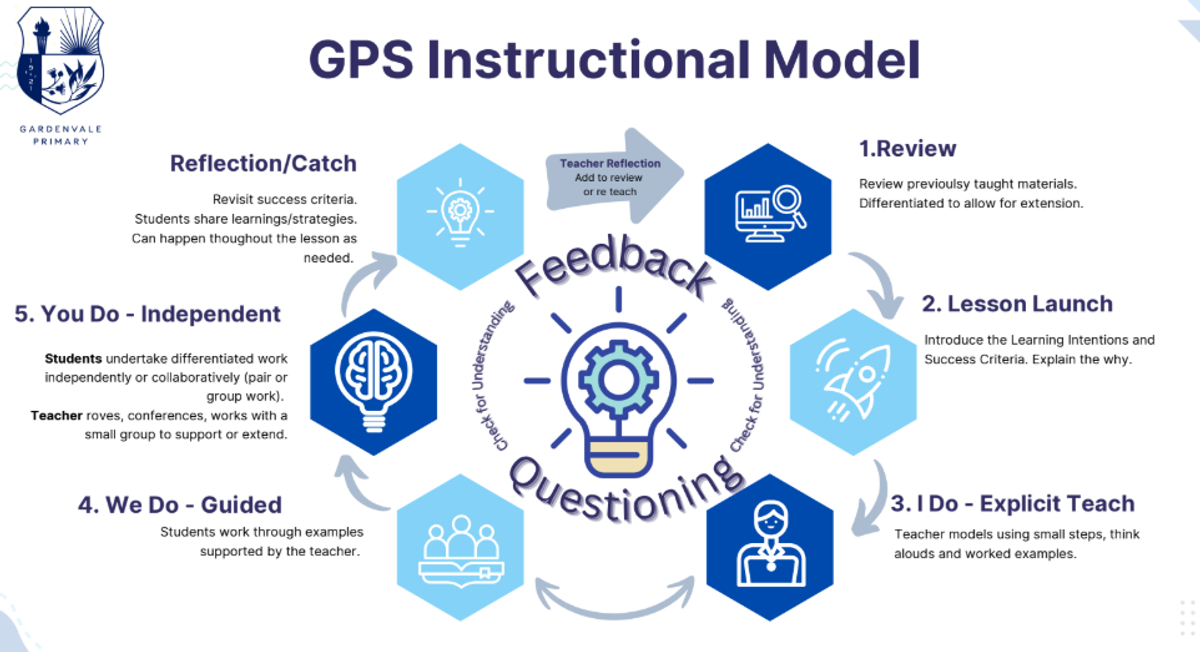Teaching and Learning
Explicit Teaching and the GPS Instructional Model

Teaching and Learning
Explicit Teaching and the GPS Instructional Model
Over the last couple of years we have been working on modifying our Instructional Model to align with cognitive science around how students best learn and with the Victorian Teaching and Learning Model (VTLM) 2.0.
Explicit teaching is instruction that is concrete and visible. The teacher explains new concepts and strategies in clear and concise language. It involves modelling and explaining concepts and skills using many examples. Teachers provide a high level of support as students practise and apply newly learned concepts.
Here is a visual of our Instructional Model. Each element is unpacked a little further below.


Review: As mentioned last week some lessons begin with a review, where previously taught material is revisited. This allows for students to practise and recall skills and concepts already learnt. This helps to combat the forgetting curve and to support transferring knowledge from short term to long term memory.
Lesson Launch: This is a very short part of the lesson where the teacher explains the why of the lesson. Learning intentions are made clear.
I Do (Explicit Teach)
This stage is characterised by explicit instruction as the teacher demonstrates the new skill or concept, which they have broken down into small and understandable steps to avoid cognitive overload. It involves modelling and explaining each step of the new skill, allowing students to only focus on what the teacher is doing.


We Do (Guided)
In the guided phase, students are supported to achieve the correct answer as they work collaboratively with each other or with their teacher. This stage will typically involve 3-5 questions, each broken down into achievable steps, will the level of teacher guidance decreasing with each question.
It is a very interactive process where various engagement norms are used so that all students can be involved in answering every question. There is a lot of backwards and forwards between the teacher and students, so there is high student engagement.
You Do (Independent)
This is the time for students to put into practise what they have learnt during the first two stages by practising new skills independently.
There will still be opportunities for students to ask questions or to receive additional support from their teacher during this stage, but it is expected that most students will be able to work through the questions independently. Where the teacher sees fit, they may work with a small group of students who need additional support or extension. The teacher may also be roving and giving high amounts of feedback to the students.
Reflection/Catch
The post-lesson reflection is an opportunity for students to pause and think about what they have learnt in a lesson or series of lessons. It allows them to identify aspects of the lesson that they struggled with or found unclear. Misconceptions can be discussed and learning intentions set at the beginning of the lesson can be revisited. Reflections can be individual reflection, group, or teacher directed and they help solidify learning and make it more meaningful.
In the next issue we will include some changes that have been made to the Victorian Maths Curriculum 2.0 which has impacted on the way teachers report on maths. You will see these changes in your child’s next report in July.
Dimi Sfetsas
Assistant Principal